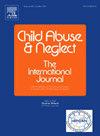亲密关系的推与拉:父母虐待儿童史阴影下的二元亲子亲密关系
IF 3.4
2区 心理学
Q1 FAMILY STUDIES
引用次数: 0
摘要
父母虐待儿童的历史可能会影响亲子亲密感的感知。然而,过去的研究通常只从父母或孩子的角度来检验这一点。本研究以亲密关系框架探讨亲子关系中知觉亲密的二元性。目的研究CM暴露与三个结果之间的联系:感知父母与年轻人的亲密关系,后代感知父母与父母的亲密关系,以及感知差异。我们还探讨了创伤后应激PTS、自组织DSO障碍、焦虑依恋和回避依恋作为潜在的潜在机制。方法452对父母子女完成自我报告问卷,评估CM、CPTSD症状(PTS和DSO)、依恋和亲密关系。结果scm对亲密感的影响有好有坏。对于父母来说,CM通过PTS与较低的感知亲密相关(间接影响= - 0.48;p < 0.05),但通过DSO与较高的感知亲密相关(间接影响= 0.09;p < 0.01)。对子代而言,CM通过DSO与感知亲密关系呈正相关(间接效应= 0.077;p < 0.05),通过回避依恋与感知亲密关系呈负相关(间接效应= - 0.087;p < 0.01)。在亲密差异方面,父母CM通过PTS呈负相关(间接影响= - 0.049;p < 0.01),通过焦虑依恋呈正相关(间接影响= 0.029;p < 0.05)。结论CM病史对亲子亲密关系的影响路径复杂,PTS和DSO的影响相反。依恋类型是这些跨代过程的关键中介。本文章由计算机程序翻译,如有差异,请以英文原文为准。
The push and pull of closeness: Dyadic parent-offspring intimacy in the shadow of parental history of child maltreatment
Background
Parental history of child maltreatment (CM) may affect perceived parent-child closeness. However, past research often examines this from either the parent's or child's perspective alone. This study uses an intimacy framework to explore the dyadic nature of perceived closeness in parent-child relationships involving CM.
Objective
We examine the links between CM exposure and three outcomes: perceived parental intimacy with young adults, offspring's perceived intimacy with parents, and perception discrepancies. We also explore posttraumatic stress PTS, disturbances in self-organization DSO, anxious attachment, and avoidant attachment as potential underlying mechanisms.
Methods
452 parent-offspring dyads completed self-reported questionnaires assessing CM, CPTSD symptoms (PTS and DSO), attachment, and intimacy.
Results
CM had mixed effects on intimacy perceptions. For parents, CM was linked to lower perceived intimacy via PTS (indirect effect = −0.48; p < 0.05) but higher via DSO (indirect effect = 0.09; p < 0.01). For offspring, CM was positively associated with perceived intimacy via DSO (indirect effect = 0.077; p < 0.05) but negatively through avoidant attachment (indirect effect = −0.087; p < 0.01). Regarding intimacy discrepancy, parental CM was negatively associated through PTS (indirect effect = −0.049; p < 0.01) and positively through anxious attachment (indirect effect = 0.029; p < 0.05).
Conclusions
Our findings suggest CM history influences parent-child intimacy via complex paths, with PTS and DSO having opposite effects. Attachment styles are key mediators in these cross-generational processes.
求助全文
通过发布文献求助,成功后即可免费获取论文全文。
去求助
来源期刊

Child Abuse & Neglect
Multiple-
CiteScore
7.40
自引率
10.40%
发文量
397
期刊介绍:
Official Publication of the International Society for Prevention of Child Abuse and Neglect. Child Abuse & Neglect The International Journal, provides an international, multidisciplinary forum on all aspects of child abuse and neglect, with special emphasis on prevention and treatment; the scope extends further to all those aspects of life which either favor or hinder child development. While contributions will primarily be from the fields of psychology, psychiatry, social work, medicine, nursing, law enforcement, legislature, education, and anthropology, the Journal encourages the concerned lay individual and child-oriented advocate organizations to contribute.
 求助内容:
求助内容: 应助结果提醒方式:
应助结果提醒方式:


